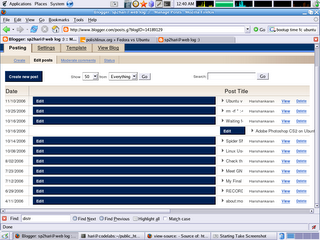Sometime back, taggy showed me
Google code search where one can search inside the source code.
And not surprisingly , the first thing he searched in source code was for "fsck" , "bitch", and "porn" .
Actually both of us were not surprised with the results. Taggy infact went to the extent of creating a graph to compare the occurence of these words in the source code. :)
Seems the coders and getting more and more frust when there code does not work and they show all their frust in their source code . Maybe a grep for "fsck" will give more shocking results :P.
If you wann to see the stats of the occurence , check out taggy's blog
hereSome of the strange and nice things which i saw in the search were
1.
sofia-sip-1.11.8/libsofia-sip-ua/su/sofia-sip/su_wait.h88: #define SU_WAIT_CONNECT (FD_CONNECT)
#define SU_WAIT_ERR (0) /*
fuck this shit */
#define SU_WAIT_HUP (FD_CLOSE)
2.
linux-2.4.33.3/lib/vsprintf.c8: /*
* Wirzenius wrote this portably, Torvalds
fucked it up :-)
*/
3.
CGI.pm-3.23/t/lib/Test/More.pm381: else {
# Can't use fail() here, the call stack will be
fucked.
my $ok = @_ == 3 ? ok(0, $name )
4.
twisted/names/authority.py239: ORIGIN = line[1]
elif line[0] == '$INCLUDE': # XXX - oh,
fuck me
raise NotImplementedError('$INCLUDE directive not implemented')
5.
includes/htmlarea/plugins/SpellChecker/spell-check-ui.js36: }
// we should use innerHTML here, but IE6's implementation
fucks up the
// HTML to such extent that our poor Perl parser doesn't understand it
6.
HTTP/Request.php613: // magic quotes may
fuck up file uploads and chunked response processing
$magicQuotes = ini_get('magic_quotes_runtime');
7.
Guppi-0.40.3/src/libguppidata/guppi-data-tree.h40: should be treated as *read-only*. If you change them, you could
really
fuck things up. */
typedef struct _GuppiDataTreeNode GuppiDataTreeNode;
8.
Acme-Scurvy-Whoreson-BilgeRat-1.1/lib/Acme/Scurvy/Whoreson/BilgeRat.pm59: ($backend && $backend->isa("Acme::Scurvy::Whoreson::BilgeRat::Backend::$params{language}")) ||
die("For
fuck's sake, the
fucking backend's
fucked");
48: die("Read the
fucking manual you shitwit and at least use the constructor right!")
if(!$class || join('', keys %params) !~ /^(language)?$/);
9.
directory_administrator-1.4/src/main.c
48: // diradmin_user *
fuck = NULL;
83: gtk_widget_show (mainwindow);
//
fuckyou ();
10.
src/libstdc++-v3/testsuite/27_io/ofstream_members.cc88: bool test = true;
const char* strlit01 = "
fuck war";
const char* strlit02 = "two less cars abstract riot crew, critical mass/SF";
Ofcourse i cannot copy paste all the
32,600 search results here :)
So do i swear when i write code ?? Of course i do , even i am a programmer right. While testing the sms code for the spider server, it used to creash often. Though i found out that i have not read the mysql manual properly , this is the source code i wrote to find the error.
cout << "Mysql Connected Successfully\n ";
update_query = Query("INSERT INTO hari_feedback VALUES ('','a','b','c','d','e','f')");
cout << "INSERT INTO hari_feedback VALUES ('','a','b','c','d','e','f')";
cout << "Query Returned " << update_query << endl;
if (update_query == NULL ) {
cout << "Fuck\n"; }
mysql_affected_rows (&sqlHandle);
if (pid == -1)
{ cout << "Query Failed\n";}
else
{ cout << "Success\n";}
And ofcourse a ls in the /tmp folder in the nosip folder shows this
fileXo1MAJ
fucku.py
fucku.xml
fuckyouman.py
fuckyouman.xml
fuckyou.py
fuckyou.xml
gcalc.py
gcalctool_log.xml
gcalctool.py
gcalctool.py~
gcalctool_run.xml
gcalctooltemp_log.xml
gcalctooltemp.
Seems even i am fscked up sometimes when it comes to coding :P









